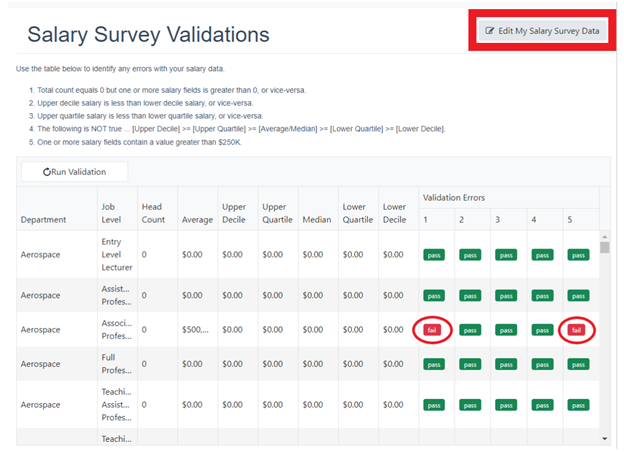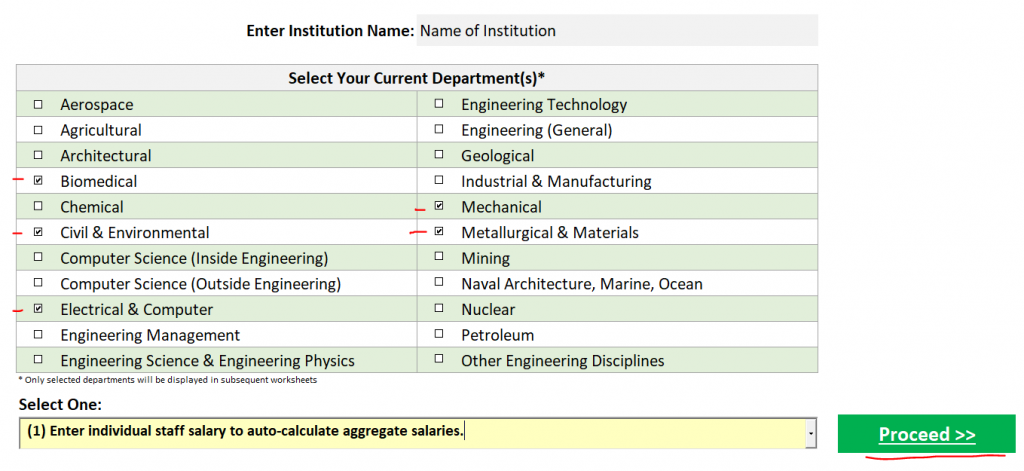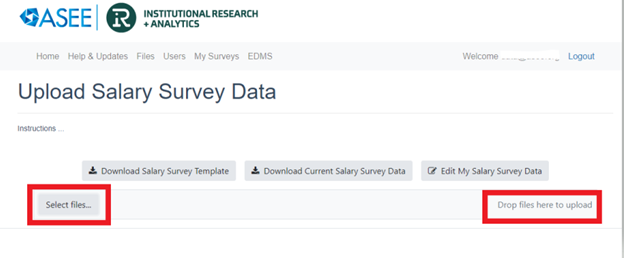Last Updated: January 24, 2025
The faculty salary survey was expanded in 2022 to include new roles and expanded set of departments. Institutions are asked to report Median, Average, Upper and Lower Quartiles/Deciles for each academic rank in each department as well as headcounts.
It may not be possible due to cohort sizes to report all statistics for each rank. Please report average and median salaries, then quartiles, and finally deciles based on cohort size.
All data reported out will include at least 5 institutions averaged reported data (no single participating institution’s data will be visible to other participants).
Please report salaries as of November 1, 2024.
All salary should be reported on a 9-month basis. If you have a 10, 11 or 12 month contract, please convert to a 9-month salary using the same conversion rate your institution reports to IPEDS or the American Association of University Professors (AAUP). Historically, AAUP and IPEDS have used 9/11 or 0.81818181818 as a default conversion factor. However, another value may be more appropriate depending on the exact lengths of the faculty contracts at an institution. If you wish to convert 12-month amounts equally into 9-month equivalent period, please use a conversion factor of 0.75. For example, if a faculty member is on a 12-month contract for $100,000 then the 9-month equivalent to report is $75,000.
Only report full-time salaries for all ranks. Do not include faculty (at any rank) with administrative roles that have separate/independent salary scales. Do not include stipends that are not part of base salary (e.g. if someone gets a stipend to serve as Chair of Grad Studies, that stipend should not be included).
For Peer Reporting Tool instructions, click here.
At this time, the deadline is April 15, 2025 May 1, 2025
Table of Contents
- Logging in or Registering
- Accessing the Survey
- Selecting Departments
- Filling Out Online
- Data Validation
- Downloading the Excel File
- Uploading Your File
- Academic Rank Definitions
Accessing the Faculty Salary Survey
The ASEE Faculty Salary Survey is now on the https://survey.asee.org website. Here is how to access it.
1. Logging in or Registering – If you do not already have an account on the site, or you are not sure if you have an account, you can request access by emailing data@asee.org. (Please note, if you were able to access the Faculty Salary Survey on the old website, and you also already had an account to access the EDMS and/or the Profiles Survey, you should automatically have Faculty Salary Survey access on the https://survey.asee.org website.)
Once this is complete, log in using your username (your email address) and the password you set.


If you have forgotten your password or it is not working, do not attempt to use it more than once or you will be locked out. Instead, use the forgot password link on the login page, or the link here: https://survey.asee.org/Identity/Account/ForgotPassword
2. Accessing the Survey – One you are logged in, click on the My Surveys tab on the top of the page.

This will take you to a page that looks like this. Make sure you are in the 2024 side tab. You may or may not also have registrations for other surveys there. You can ignore these, look for the Faculty Salary Survey, and click the blue “Access Salary Survey” button, all pictured below:

3. Selecting Departments – Once you have clicked the “Access Salary Survey” button, you will come to this page:

The first time you open the survey, you will need to navigate to “Edit My Salary Survey Data” option before filling out the online survey; you will need select which departments you will be reporting upon on the following page, and at least one must be checked or nothing will populate:

4. Filling Out Online – Now that you have selected the departments you will be reporting on, your selected departments will populate the online method of filling out the survey, which will be “Edit My Salary Survey Data” pictured below. (for Excel instructions, skip to #6)

If you “Edit My Salary Survey Data” the next pages will look like what is pictured below, and you can enter numbers in and keep clicking “Continue” until you reach the last page, and you can refer to the top progress bar to indicate where you are:


At the end, once you have entered all your data, you will reach a blue button called “Validate Data.” Click it to proceed to the next step.

5. Data Validation – At the data validation stage, your screen will indicate what you may need to correct based on the numbers entered. If you do, you can navigate back to the Edit My Salary Survey Data page using the top right button.

6. Downloading the Excel file
You can use the Excel file instead of the online tool by downloading the Excel file:

Once opened, you will use the top navigation bars to get around within the survey:

Like the Online version, you will need to select the departments you wish to have as options to populate your survey. Then once selected, you will hit the “Proceed” button:

You can then use the drop-down menu in the first column to select which department to enter data for:

After you enter the salaries, there is a validation error section that you can use to check your work:

PLEASE NOTE: In the Excel file, if you perform the following actions, it will corrupt the spreadsheet and cause errors when uploading:
- Copying and pasting Department Names instead of selecting them from the drop-down menus
- Copying and pasting the template into a new file and using that new file instead
- Attempting to break through or work around the password protected areas
If you are experiencing any issues with the spreadsheet, please reach out to us.
7. Uploading Your File – When you are ready to upload your file, you may do so on the “Edit My Salary Survey Data” page. You can either upload it by browsing for it, or by dragging it and dropping it. Please keep in mind the file must be a .xlsx.
If you are then able to view your uploaded data in the “Edit My Salary Survey Data”, and there are no validation check errors, then you have successfully completed the survey.

8. Academic Ranks
There are a number of different practices that could effect compensation institution to institutions — for example, teaching assistant professors may have a service requirement at one institution, but another institution may not include service as part of a teaching. Salary surveys cannot capture that variability in function or role without a substantial increase in reporting burden, but rely on title to assist with benchmarking salary comparisons.
Professor, Associate Professor and Assistant Professor: This includes tenured/tenure track ladder faculty with full-time appointments.
Entry-level Lecturers: This category was created in 2012 to include all full-time non-tenure track faculty who have a primarily instructional role within the first five years of hire regardless of title. This title was retained because a number of participants indicated the usefullness of being able to benchmark this information.
Teaching Assistant Professors, Teaching Associate Professor and Teaching Full Professor: This includes all primarily instructional ladder faculty with a non-tenure track appointment with full-time appointments. These include faculty who have a ranked faculty position with teaching in the title to include teaching assistant professors, assistant teaching professor, assistant professor (instructional stream) and similarly worded titles. This does not include faculty titled lecturers or instructors.
Instructors: This includes all primarily instructional faculty with the title of instructor or a modified form of instructor (i.e. senior instructor, term instructor, etc.) with full-time appointments
Lecturers: This includes all primarily instructional faculty with the title of lecturer or a modified form of lecturer (i.e. Lecturer III, Senior Lecturer, etc.) with full-time appointments.
Postdoctoral Scholars: This includes all full-time staff in a postdoctoral scholar position with full-time appointments (including fellows, scholars, researchers and other titles with the postdoctoral modification) that can include elements of instructional, research and service.
